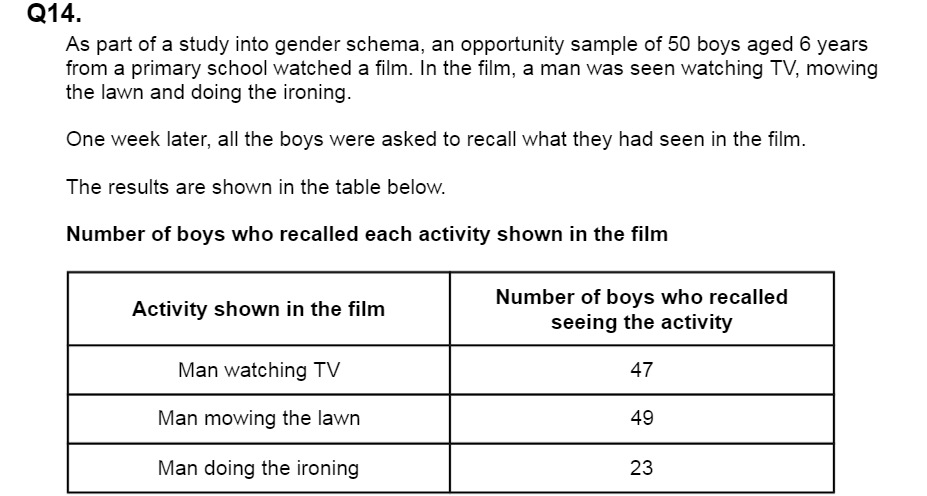Gender schema theory
1/4
Earn XP
Description and Tags
gender schema theory
Name | Mastery | Learn | Test | Matching | Spaced |
|---|
No study sessions yet.
5 Terms
Discuss gender schema theory [16 marks]
Gender schema theory is a cognitive explanation proposed by Martin and Halverson who claimed that Kohlberg’s theory was flawed as the process of gender occurred much earlier on than what was suggested.
Schemas are cognitive frameworks organising information in our brains. Gender schemas are mental representations about appropriate behaviour for each gender e.g. boys play football and are very easily influenced by stereotypes.
Gender schema theory suggests that first a child establishes gender identity (around 2-3 years) The child then begins to look around for further information to develop their schema. These schemas are often based on stereotypes.
Martin and Halverson (1981) describe two types of sex-related schemas: in-group schemas (the group with which a person identifies); and out-group schemas (the opposite group). Once a child has identified with their in-group, they begin to positively evaluate their own group and negatively evaluate the out-group.
IN GST by 6 years old, children have fixed and stereotypical idea about gender appropriate behaviour, so ignore contradictory information (e.g. a male nurse)
In GST from 8-10 years’ old
Children develop schemas of the opposite gender matching the complexity of their own gender schema that they have for themselves.
AO3
One strength of GST is that there is supporting research. Martin and Halverson (1983) found that children under 6 were more likely to recall gender-appropriate photographs than gender-inappropriate ones when tested a week later. Children tended to change the gender of the person carrying out the gender inappropriate activity in the photographs when asked to recall them. This supports GST which predicts that children under 6 would do this (in contrast with Kohlberg who said this happens in older children)
One strength of GST is that it can account for cultural differences. Cherry (2019) argues gender schemas not only influence how people process information but also what counts as culturally-appropriate gender behaviour. In societies where perceptions of gender have less rigid boundaries, children are more likely to acquire non-standard gender stereotypes. This contrasts with some other explanations of gender development, such as psychodynamic theory which suggest gender identity is more driven by unconscious biological urges.
It can be argued that GST theory can complement Kohlberg’s theory. This has been supported by Stangor and Ruble who suggest that gender schemas and gender constancy are different processes, with schema being about storing of information and constancy being about motivation. This shows, that in order to fully understand gender development from a cognitive perspective both theories combined would provide a much more thorough account of exactly how gender development occurs, in comparison to a singular approach

Schemas are cognitive frameworks organising information in our brains, in relation to gender in children it is about each sex and sex appropriate behaviour.
GST suggests that first a child establishes gender identity (around 2-3 years) The child then begins to look around for further information to develop their schema. These schemas are often based on stereotypes.
In group schemas: Children tend to have a much better understanding of schemas appropriate to their own gender.
Beatrix only wants to talk about the in-group
Playing with gender-appropriate toys perhaps due to stereotypes that only the girls at nursery should play with dolls..

The recall of the activities of watching TV and mowing the lawn was almost
perfect / extremely high, but recall for ironing was only 23 / 50 or just less than half.
Schemas are cognitive frameworks organising information in our brains. Gender schemas are mental representations about appropriate behaviour for each gender e.g. boys play football and are very easily influenced by stereotypes.
forgetting the ironing behaviour which does not fit the schema or stereotype
(b) The sampling method used in the study was opportunity sampling.
What is meant by opportunity sampling?
Is where a researcher decides to select anyone who is available and willing to participate in their study.
Using a gender-related example, explain one reason why some adult behaviours or actions seen by children are not copied [2 marks]
If a child receives criticism for imitating an adults behaviour or actions. For instance, a young girl does not copy her father washing the car because she has been told, ‘that’s a man’s job.